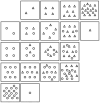Clash of the Invaders: Competition Dynamics of Bromus tectorum and Ventenata dubia in an Addition Series Study
- PMID: 40391118
- PMCID: PMC12086993
- DOI: 10.1002/ece3.71458
Clash of the Invaders: Competition Dynamics of Bromus tectorum and Ventenata dubia in an Addition Series Study
Abstract
Competitive interactions between co-occurring invasive species can have detrimental impacts on native communities and cause counter-effective responses to management. Targeted removal of one invader may allow for the release of a subdominant invader, causing a secondary invasion. The goal of this research was to elucidate competitive dynamics between Bromus tectorum and Ventenata dubia, two invasive winter annual grasses found in the western United States. We quantified the impacts of (1) intraspecific competition on B. tectorum and V. dubia as the density of conspecifics increased and (2) interspecific competition between the two at varying proportions. The two species were grown at increasing densities and proportions (addition series) over 10 weeks in a greenhouse. Aboveground biomass was harvested and weighed. We derived the intraspecific and interspecific competitive effects on each species with a nonlinear analysis and used these coefficients to determine relative competitive ability (RCA). Both species were impacted by interspecific competition and intraspecific competition. More conspecifics were required to cause a decline in both species' biomass relative to the number of allospecifics that caused the same response. Interestingly, the number of allospecific individuals to imposed an impact was similar. The RCA values for both species were < 1, which indicated that interspecific competition had a greater influence on both species than intraspecific competition. This suggests that the replacement of B. tectorum by V. dubia is unlikely to be caused by aboveground competition alone. However, there are differences in germination timing between the two species; both germinate in the fall, but V. dubia also germinates in the spring. Management that targets fall-germinating individuals may reduce B. tectorum and fall-germinating V. dubia but not impact spring-germinating V. dubia, which may release these individuals from competition. Understanding the competitive interactions between these species provides insight into invasive species impacts and management.
© 2025 The Author(s). Ecology and Evolution published by British Ecological Society and John Wiley & Sons Ltd.
Conflict of interest statement
The authors declare no conflicts of interest.
Figures



References
-
- Adhikari, A. , Mangold J., Mainali K. P., and Rew L. J.. 2022. “Climate Change and More Disturbed Land‐Use Types Will Further the Invasion of a Non‐Native Annual Grass, Ventenata dubia .” Biological Invasions 25, no. 1: 285–296.
-
- Bansal, S. , James J. J., and Sheley R. L.. 2014. “The Effects of Precipitation and Soil Type on Three Invasive Annual Grasses in the Western United States.” Journal of Arid Environments 104: 38–42.
-
- Barabás, G. , D'Andrea R., and Stump S. M.. 2018. “Chesson's Coexistence Theory.” Ecological Monographs 88: 277–303.
-
- Barkworth, M. , Capels K., and Long S.. 1993. Flora of North America North of Mexico, edited by Committee, Flora of North America Editorial , 683–684. Oxford University; Ventenata.
LinkOut - more resources
Full Text Sources

